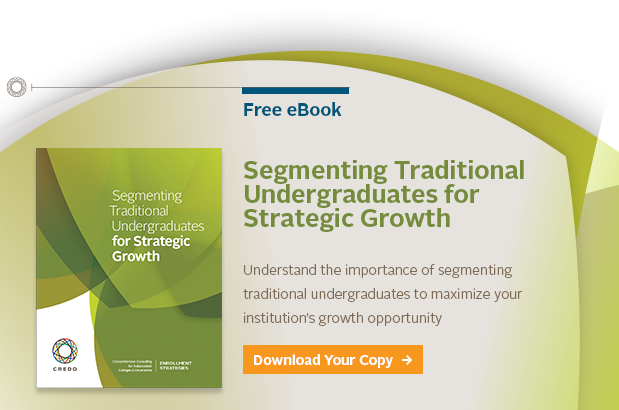
August 26 2016
Traditionally, the steps of the enrollment funnel were simple, straightforward and consistent across the higher education industry. You may recognize the steps of the funnel as “Prospects > Inquiries > Applicants > Admits”, but there are now several other steps that take place between these milestones.

The current reality for today’s campus enrollment officers is that the enrollment funnel has changed dramatically and is no longer a one-size-fits-all model. It’s evolved over time to account for the various types of students who enter the enrollment funnel and the different stages in the admissions process.
So, what’s so different about today’s enrollment funnel? And how can you use these changes to your institution’s advantage?
The Internet Can Make Prospective Students Seem Invisible… But It Doesn’t Have To
The introduction of the Internet fundamentally changed the traditional enrollment funnel. Each person in the funnel - from initial prospects to alumni - areis using the internet to interact with your institution at various phases of the process. Web-savvy prospective students use online tools to find and explore schools that meet their interests, and can use their smartphones to submit applications.
Oftentimes, applicants are finding your institution and evaluating it invisibly from the internet. This makes your inbound marketing strategy on your website crucial. Create touch points on your university’s website that collect information about prospective students, such as email sign-ups to receive updates about the admissions process. This allows you to nurture the relationship with the prospective student as they go along the enrollment funnel.
Capturing their information also allows you to turn data into action by learning more about the types of students that are interested in your institution and developing a strategy to connect with them in a more meaningful way. For example, if you create an email campaign targeted at prospective students, you can evaluate the types of emails students open and click on to help you continuously improve your marketing strategy.
Without capitalizing on these web opportunities, prospective students will continue to be invisible to you throughout the enrollment funnel. Instead, track your prospective students so you can better market your institution.
The Campus Experience is More Important than Ever
Not too long ago, the traditional enrollment funnel was a static process that was easy to predict. A prospective student would inquire about the university, apply and eventually become a new student. Now, the enrollment process is less of a funnel and more like a puzzle with various pieces. The campus experience’s role in capturing the attention of prospective students remains an essential piece, but it is in the approach of making it memorable where enrollment officers should learn to get creative.
There is plenty of opportunity for campuses to get creative with their digital experience. Now more than ever, having a strong digital presence is critical to reaching prospective students. To meet the components of the new enrollment funnel, consider the option of a virtual tour. Although a virtual tour does not replace physical campus visits, if done well, it can inspire a prospective student to visit your campus, narrow down their pool of options or even submit an application.
Virtual tours and other digital touchpoints can help you create a more memorable campus experience.
Applications No Longer Mean a Highly Interested Prospective Student
In the traditional enrollment funnel, a submitted application signaled that a student had a very high level of interest in attending an institution. In the new enrollment funnel however, submitted applications simply don’t carry as much weight. There is a more streamlined application process with shorter online applications - sometimes only taking 5-10 minutes to complete - often with a fee waiver in place to make students more likely to apply.
Because of this shift in the weight of applications, the sheer number of applications received no longer carries as much importance when measuring enrollment success as it did in the past. To adapt to this change, progress should be measured by the number of completed applications and registered students.
Admitted/Deposited Ratios Don’t Carry as Much Weight as They Used to
The number of admitted students/deposits paid doesn’t carry as much weight in the new enrollment funnel either. An easy application process allows students to place deposits at multiple schools with minor effort. Unlike in the past where the majority of your admitted students inevitably attended your institution, attendance numbers for many institutions remain mostly uncertain until the first week of classes.
With this change in traditional enrollment, it is important to communicate more frequently with these admitted/deposited students, increasing their likelihood of choosing your campus. Staying relevant in their minds can set your institution apart from others they’re considering attending.
How the New Enrollment Funnel Impacts Enrollment Managers
If your current funnel has thousands of students who are not earnestly interested in your institution, you are likely undermining resources that could be used elsewhere to attract best-fit students.
Enrollment managers should be able to look at current enrollment strategies with a quantitative eye, quickly understanding what works and what needs adjusting in order to attract best fit students.
Final Thought: Don’t Overlook Prospective Students in the Applicant Stage
It’s very easy for enrollment managers to focus on prospective students earlier on in the funnel and neglect those further down. Especially now that applications and deposits don’t hold as much weight as before, it’s critical that enrollment manages prospects all the way to the end of the funnel. Doing this will ensure that you have more students on the first day of classes.
 to learn how you can adapt your current enrollment strategies to meet the new enrollment funnel.
to learn how you can adapt your current enrollment strategies to meet the new enrollment funnel.
Related Blog Posts
Recent Posts
- Richard Dunsworth, J.D., To Receive 12th Annual Courageous Leadership Award December 16 2024
- Meet the 2024 Credo Values Award Recipients August 27 2024
- What is Executive Coaching, Really? June 25 2024
- Credo & The Constructive Dialogue Institute Announce A New Partnership For Higher Education Leadership Development March 7 2024
- Celebrating Women And Gender-Diverse Learners & Leaders February 28 2024
Categories
- Strategy
- Leadership
- Student Success
- Student Success & Retention
- Enrollment
- Pivot
- Strategic Planning
- Leadership Development
- News
- Strategic Enrollment
- Campus Planning and Architecture
- Moving the Needle
- Data
- Research
- Retention
- Campus Master Planning
- Enrollment & Financial Aid
- Academic Programming
- Campus Planning
- Thriving
- Admitted Student Research
- Architecture
- Finance
- Advising
- Admissions




